Broadband Spectra and Efficient Laser Performance of a Disordered Nd:Sr0.7La0.3Mg0.3Al11.7O19 Crystal
Abstract
:1. Introduction
2. Results and Discussion
2.1. Spectral Characterization of the Nd:ASL Crystal
2.2. Continuous-Wave and Passive Q-Switched Lasers of Nd:ASL Crystal
3. Conclusions
Author Contributions
Funding
Acknowledgments
Conflicts of Interest
References
- Yim, J.H.; Cho, W.B.; Lee, S.; Ahn, Y.H.; Kim, K.; Lim, H.; Rotermund, F. Fabrication and characterization of ultrafast carbon nanotube saturable absorbers for solid-state laser mode locking near 1 μm. Appl. Phys. Lett. 2008, 93, 161106. [Google Scholar]
- Basiev, T.T.; Es’kov, N.A.; Karasik, A.Y.; Osiko, V.V.; Sobol, A.A.; Ushakov, S.N.; Helbig, M. Disordered garnets Ca3(Nb, Ga)5O12:Nd3+—Prospective crystals for powerful ultrashort-pulse generation. Opt. Lett. 1992, 17, 201–203. [Google Scholar] [CrossRef] [PubMed]
- Keller, U. Recent developments in compact ultrafast lasers. Nature 2003, 424, 831–838. [Google Scholar] [CrossRef] [PubMed]
- Horvath, C.; Braun, A.; Liu, H.; Juhasz, T.; Mourou, G. Compact directly diode-pumped femtosecond Nd:glass chirped-pulse-amplification laser system. Opt. Lett. 1997, 22, 1790–1792. [Google Scholar] [CrossRef] [PubMed]
- Loiko, P.A.; Kisel, V.E.; Kondratuk, N.V.; Yumashev, K.V.; Kuleshov, N.V.; Pavlyuk, A.A. 14W high-efficiency diode-pumped cw Yb: KGd(WO4)2, laser with low thermo-optic aberrations. Opt. Mater. 2013, 35, 582–585. [Google Scholar] [CrossRef]
- Koechner, W. Solid-State Laser Engineering; Springer: New York, NY, USA, 2006. [Google Scholar]
- Yu, H.H.; Liu, J.H.; Zhang, H.J.; Kaminskii, A.A.; Wang, Z.P.; Wang, J.Y. Advances in vanadate laser crystals at a lasing wavelength of 1 micrometer. Laser Photonics Rev. 2014, 8, 847–864. [Google Scholar] [CrossRef]
- Liu, J.; Wang, Z.; Meng, X.; Shao, Z.; Ozygus, B.; Ding, A.; Weber, H. Improvement of passive Q-switching performance reached with a new Nd-doped mixed vanadate crystal Nd: Gd0.64Y0.36VO4. Opt. Lett. 2003, 28, 2330–2332. [Google Scholar] [CrossRef] [PubMed]
- Barnes, N.P.; Gettemy, D.J.; Esterowitz, L.; Allen, R. Comparison of Nd 1.06 and 1.33 µm operation in various hosts. IEEE J. Quantum Electron. 1987, 23, 1434–1451. [Google Scholar] [CrossRef]
- Mackenzie, J.I. Power-scaling Nd: YAG’s quasi-four-level transition. In Proceedings of the SPIE–The International Society for Optical Engineering, San Francisco, CA, USA, 17 February 2010; p. 7578. [Google Scholar]
- Han, S.; Lu, W.; Sheh, B.Y.; Yan, L.; Wraback, M.; Shen, H.; Newman, P.G. Generation of sub-40 fs pulses from a mode-locked dual-gain-media Nd: Glass laser. Appl. Phys. B 2002, 74, 177–179. [Google Scholar] [CrossRef]
- Xie, G.Q.; Tang, D.Y.; Luo, H.; Zhang, H.J.; Yu, H.H.; Wang, J.Y.; Tao, X.T.; Jiang, M.H.; Qian, L.J. Dual-wavelength synchronously mode-locking Nd: CNGG laser. Opt. Lett. 2008, 33, 1872–1874. [Google Scholar] [CrossRef] [PubMed]
- Yu, H.H.; Xu, X.D.; Li, D.Z.; Wang, Z.P.; Xu, J. High-power disordered Nd:CaYAlO4 laser at 1.08 μm. Opt. Lett. 2010, 35, 2666–2668. [Google Scholar] [CrossRef] [PubMed]
- Ma, J.; Pan, Z.; Cai, H.; Yu, H.; Zhang, H.; Shen, D.; Tang, D. Sub-80 femtosecond pulses generation from a diode-pumped mode-locked Nd:Ca3La2(BO3)4 disordered crystal laser. Opt. Lett. 2016, 41, 1384–1387. [Google Scholar] [CrossRef] [PubMed]
- Wyckoff, R.W.G. Crystal Structures, 2nd ed.; Wiley Interscience: New York, NY, USA, 1965; p. 981. [Google Scholar]
- Gheorghe, L.; Lupei, V.; Lupei, A.; Gheorghe, C.; Varona, C.; Loiseau, P.; Ferrand, B. Czochralski growth and characterization of neodymium-doped strontium lanthanum aluminate (ASL: Nd) single crystals. J. Cryst. Growth 2005, 277, 410–415. [Google Scholar] [CrossRef]
- Delacarte, V.; Thery, J.; Vivien, D. Optical fluorescence and fluorescence dynamics of Nd3+ in Sr1−xNdyLax−yMgxAl12−xO19 (ASL: Nd). J. Lumin. 1994, 62, 237–243. [Google Scholar] [CrossRef]
- Sattayaporn, S.; Loiseau, P.; Aka, G.; Marzahl, D.-T.; Krankel, C. Crystal growth, spectroscopy and laser performance of Pr3+: Sr0.7La0.3Mg0.3Al11.7O19 (Pr: ASL). Opt. Express 2018, 26, 1278–1289. [Google Scholar] [CrossRef] [PubMed]
- Zhang, Y.Y.; Zhang, H.J.; Yu, H.H.; Sun, S.Q.; Wang, J.Y.; Jiang, M.H. Characterization of disordered melilite Nd: SrLaGa3O7 crystal. IEEE J. Quantum Electron. 2011, 47, 1506–1513. [Google Scholar] [CrossRef]
- Li, D.Z.; Xu, X.D.; Cheng, S.S.; Zhou, D.H.; Wu, F.; Zhao, Z.W. Polarized spectral operties of Nd3+ ions in CaYAlO4 crystal. Appl. Phys. B 2010, 101, 199–205. [Google Scholar] [CrossRef]
- Judd, B.R. Optical absorption intensities of rare-earth ions. Phys. Rev. 1962, 127, 750–761. [Google Scholar] [CrossRef]
- Ofelt, G.S. Intensities of crystal spectra of rare-earth ions. J. Chem. Phys. 1962, 37, 511–520. [Google Scholar] [CrossRef]
- Cong, Z.H.; Tang, D.Y.; Tan, W.D.; Zhang, J.; Luo, D.W.; Xu, C.W. Diode-end-pumped Nd: CaYAlO4 mode locked laser. Opt. Commun. 2011, 284, 1967–1969. [Google Scholar] [CrossRef]
- Zhang, Y.Y.; Zhang, H.J.; Yu, H.H.; Cong, H.J.; Wang, J.Y. Growth and piezoelectric properties of melilite ABC3O7 crystals. Cryst. Growth Des. 2012, 12, 622–628. [Google Scholar] [CrossRef]
- Rao, H.; Cong, Z.H.; Qin, Z.G.; Feng, C.; Wang, Q.P.; Liu, Z.J. A diode pumped passively mode-locked Nd: CaGdAlO4 laser. Laser Phys. 2016, 26, 045802. [Google Scholar] [CrossRef]
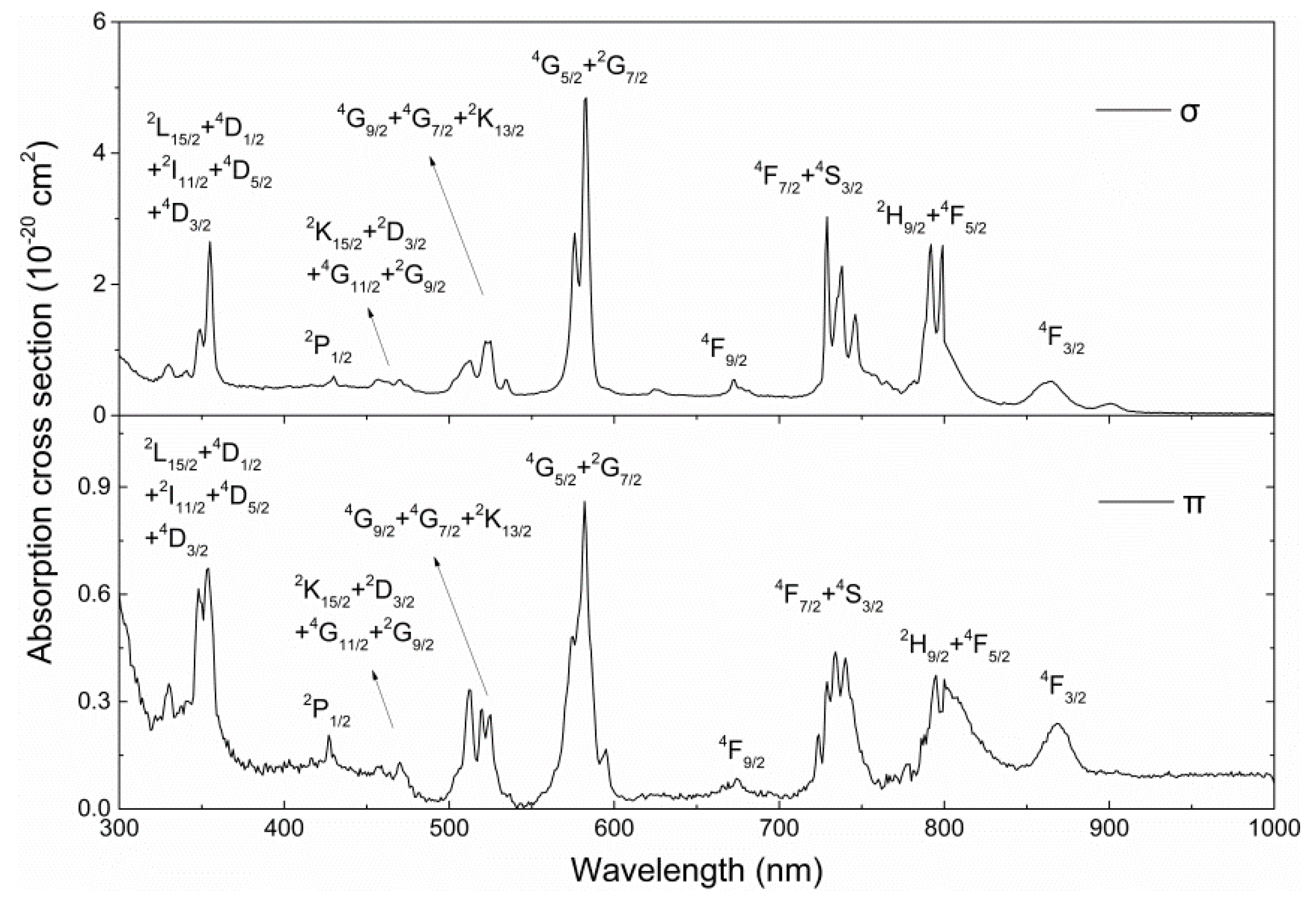
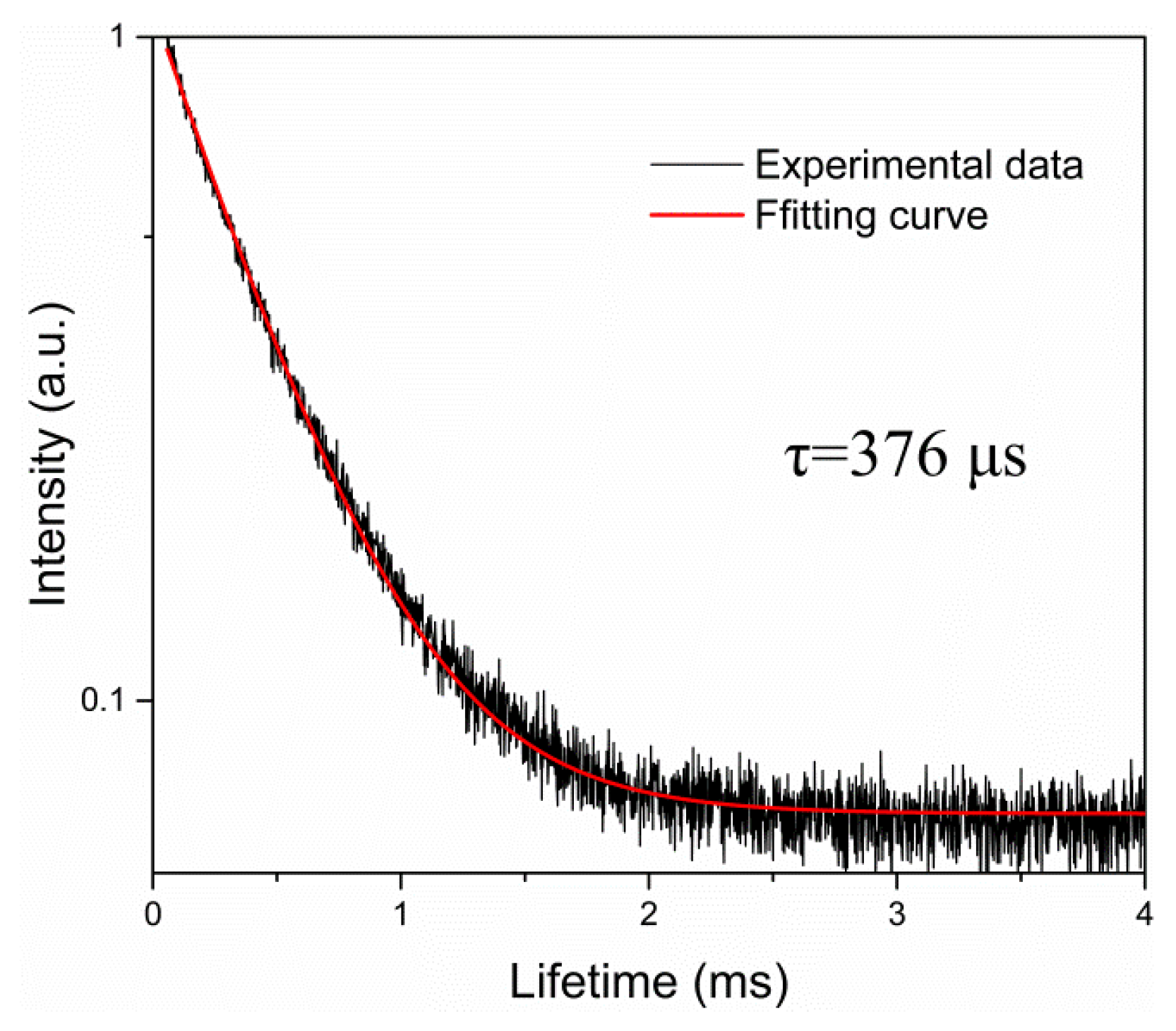
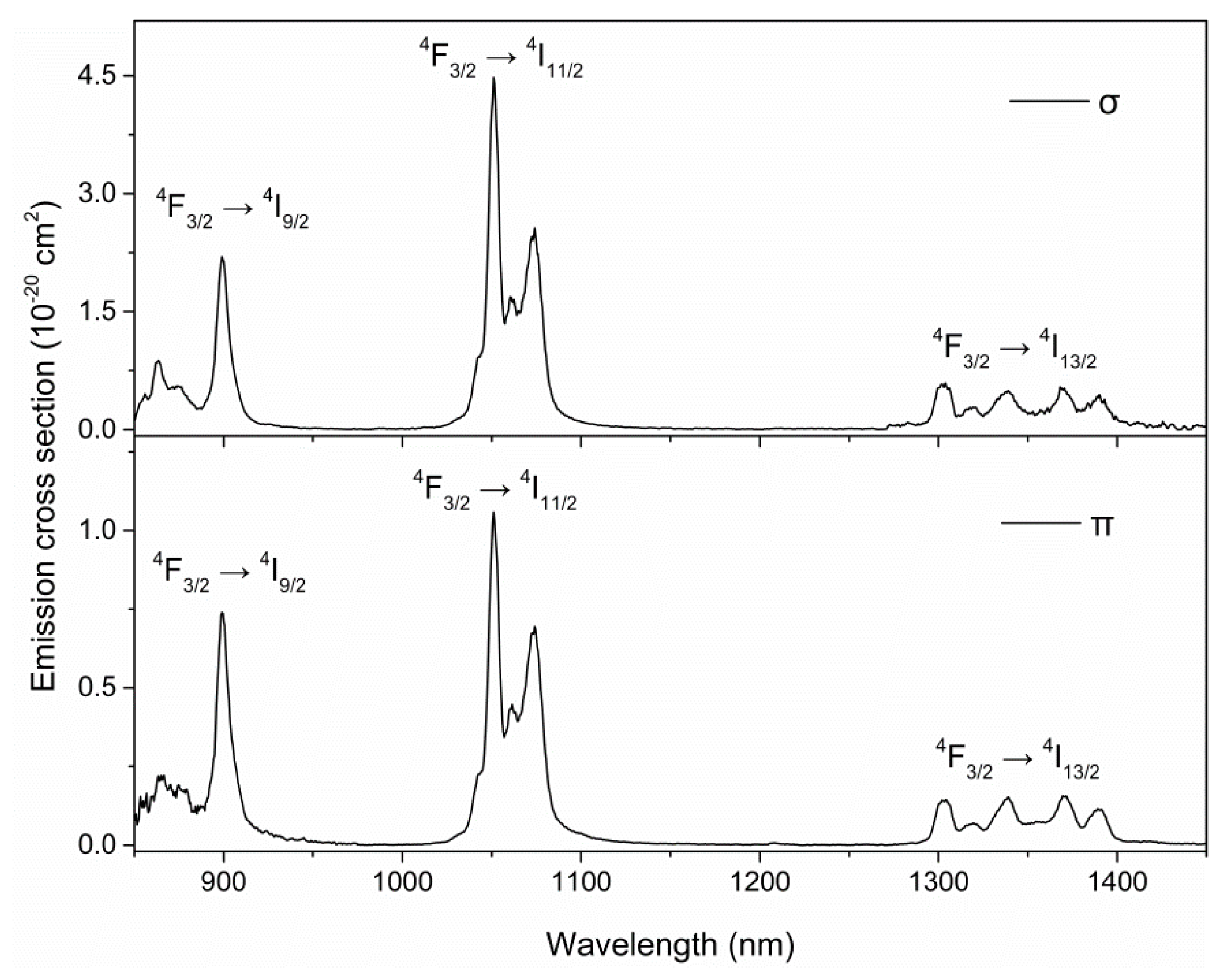

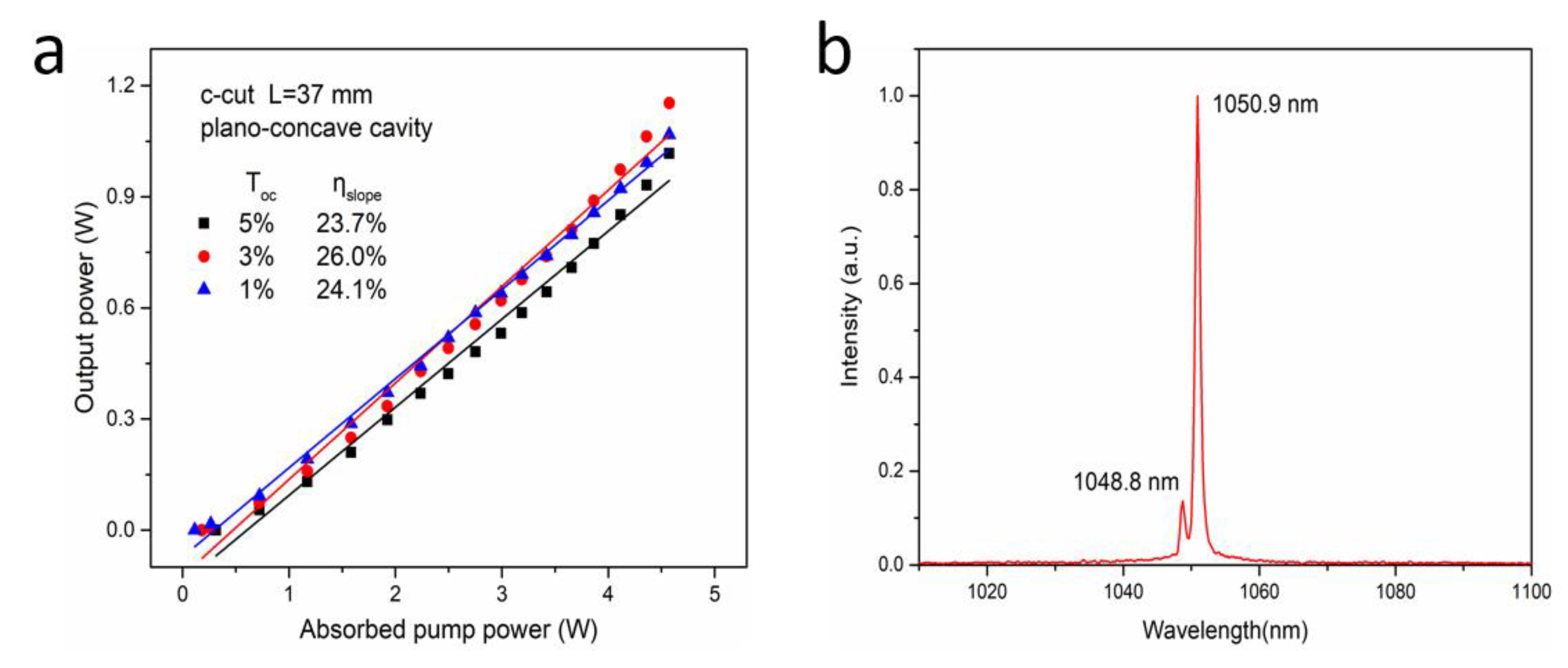
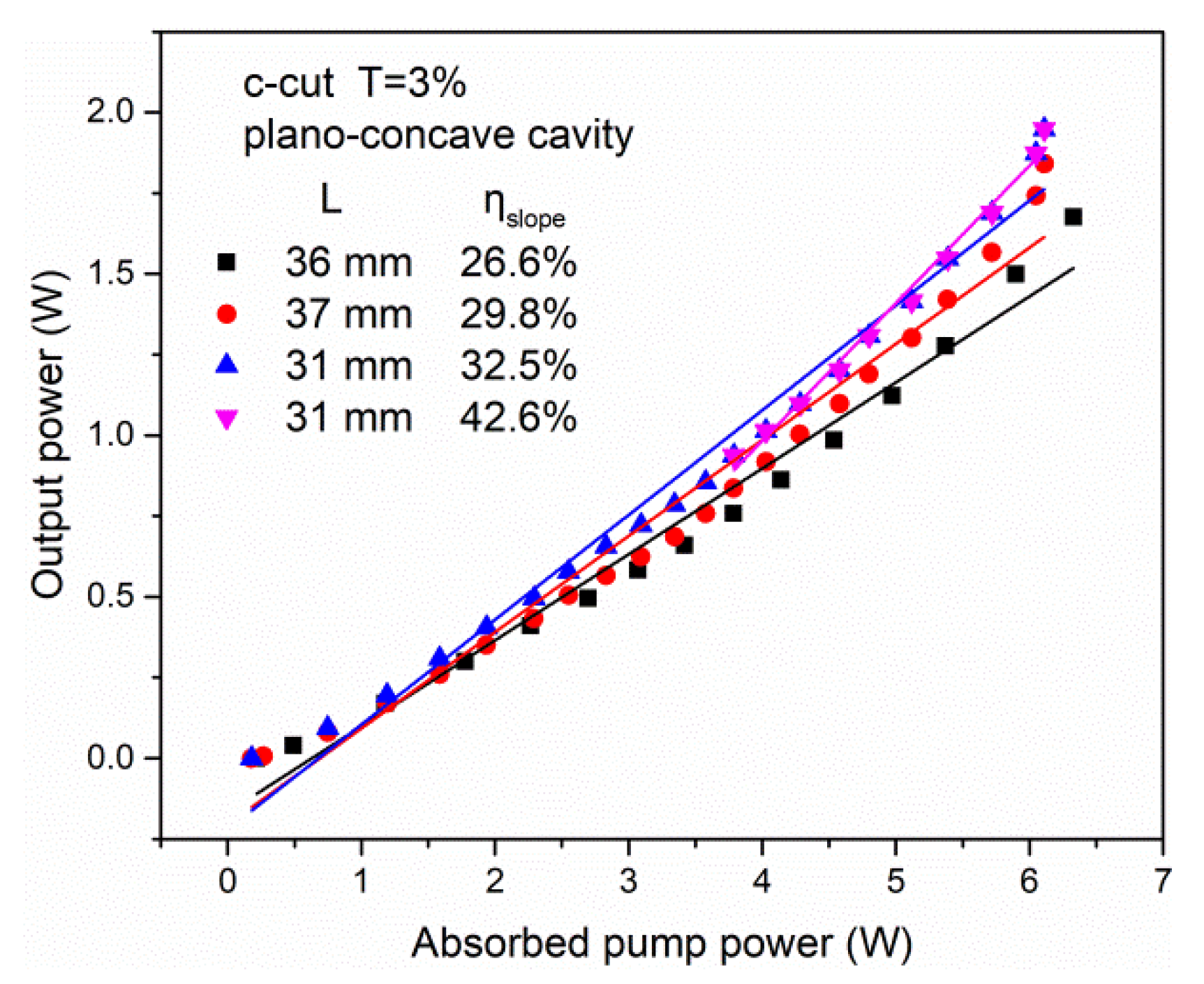

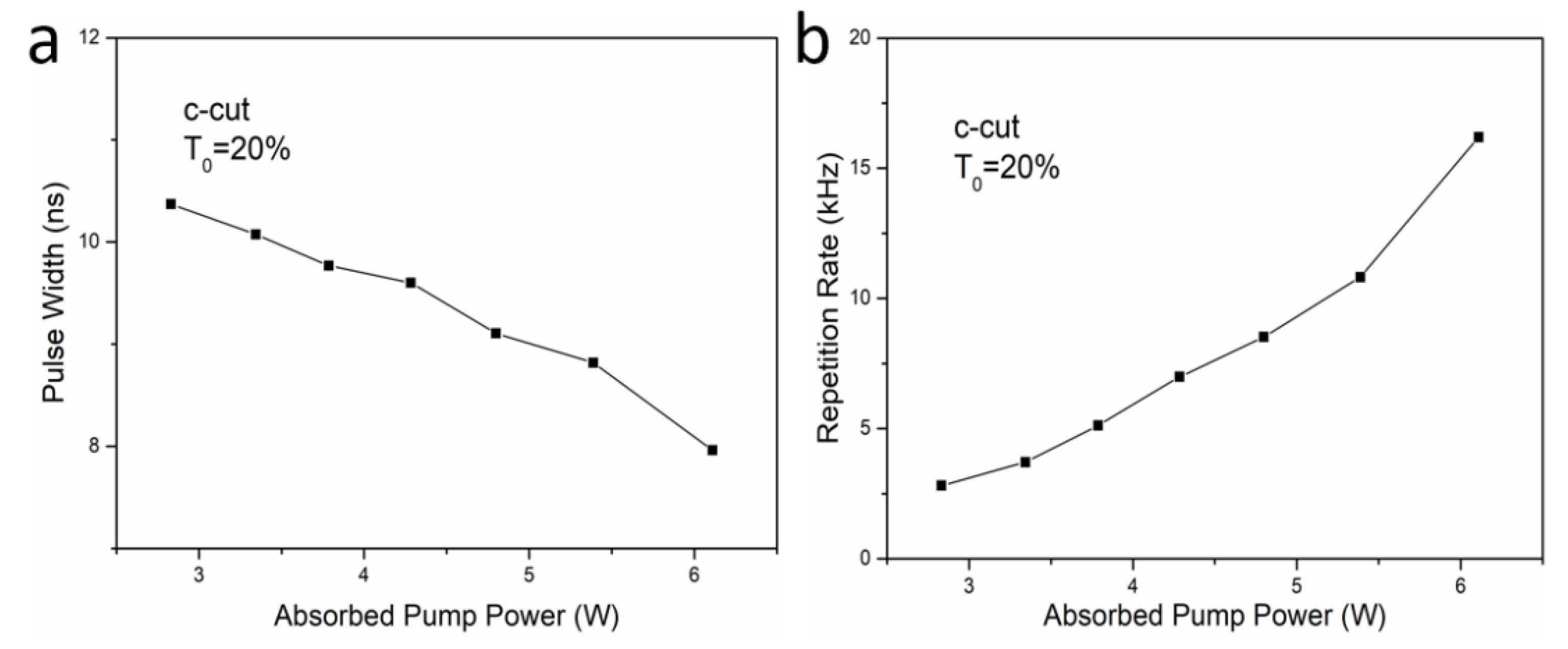
| Excited State | σ Polarization | π Polarization | ||||
|---|---|---|---|---|---|---|
| 4I9/2 | (nm) | (10−6) | (nm) | (10−6) | ||
| λ | Sexp | Scal | λ | Sexp | Scal | |
| 2L15/2 + 4D1/2 + 2I11/2 + 4D5/2 + 4D3/2 | 349 | 2.834 | 2.661 | 347 | 1.025 | 0.954 |
| 2P1/2 | 433 | 0.088 | 0.162 | 437 | 0.059 | 0.060 |
| 2K15/2 + 2D3/2 + 4G11/2 + 2G9/2 | 465 | 0.576 | 0.340 | 465 | 0.162 | 0.106 |
| 4G9/2 + 4G7/2 + 2K13/2 | 518 | 1.693 | 1.565 | 517 | 0.662 | 0.492 |
| 4G5/2 + 2G7/2 | 580 | 4.389 | 4.350 | 580 | 1.311 | 1.305 |
| 4F9/2 | 676 | 0.211 | 0.210 | 676 | 0.066 | 0.054 |
| 4F7/2 + 4S3/2 | 740 | 3.036 | 2.823 | 738 | 0.739 | 0.682 |
| 2H9/2 + 4F5/2 | 797 | 2.931 | 3.133 | 806 | 0.812 | 0.876 |
| 4F3/2 | 869 | 1.103 | 1.228 | 873 | 0.260 | 0.425 |
| RMS (10−20 cm2) | 0.182 | 0.110 | ||||
| Intensity Parameter | Ω (10−20 cm2) | ||
|---|---|---|---|
| σ-Polarization | π-Polarization | Ω = (2Ωσ + Ωπ)/3 | |
| Ω2 | 1.51 | 0.28 | 1.10 |
| Ω4 | 4.40 | 1.63 | 3.48 |
| Ω6 | 3.98 | 0.92 | 2.96 |
| Transitions | σ Polarization | π Polarization | ||
|---|---|---|---|---|
| Aσ (S−1) | βσ (%) | Aπ (S−1) | βπ (%) | |
| 4F3/2→4I9/2 | 1623.75 | 45.43 | 557.48 | 52.57 |
| 4F3/2→4I11/2 | 1636.06 | 45.77 | 430.21 | 40.57 |
| 4F3/2→4I13/2 | 308.14 | 8.62 | 71.20 | 6.71 |
| 4F3/2→4I15/2 | 6.61 | 0.18 | 1.53 | 0.14 |
| Radiative lifetime (µs) | τrad = 501 | |||
| Crystals | Properties | |||
|---|---|---|---|---|
| Emission Cross Section (10−20 cm2) | Fluorescence Bandwidth (nm) | Lifetime (μs) | Continuous-Wave Output Power (W) | |
| Nd:CNGG [12] | 5 (1059) | 15 | 210 | 3.9 |
| Nd:CaYAlO4 [20,23] | 7.53 (π), 10.44 (σ) | 15 (π), 12 (σ) | 129 | 5.16 |
| Nd:SrLaGa3O7 [19,24] | 10 | 14 | 310 | 1.16 |
| Nd:CaGdAlO4 [25] | 0.75 (σ) | 80 (σ) | 420 | 0.36 |
| Nd:ASL (present work) | 4.5 (σ), 1.1 (π) | 30 (σ), 32 (π) | 376 | 1.95 |
© 2018 by the authors. Licensee MDPI, Basel, Switzerland. This article is an open access article distributed under the terms and conditions of the Creative Commons Attribution (CC BY) license (http://creativecommons.org/licenses/by/4.0/).
Share and Cite
Zhang, N.; Xu, X.; Pan, Y.; Liu, J. Broadband Spectra and Efficient Laser Performance of a Disordered Nd:Sr0.7La0.3Mg0.3Al11.7O19 Crystal. Materials 2018, 11, 1575. https://doi.org/10.3390/ma11091575
Zhang N, Xu X, Pan Y, Liu J. Broadband Spectra and Efficient Laser Performance of a Disordered Nd:Sr0.7La0.3Mg0.3Al11.7O19 Crystal. Materials. 2018; 11(9):1575. https://doi.org/10.3390/ma11091575
Chicago/Turabian StyleZhang, Nana, Xiaodong Xu, Yuxin Pan, and Jian Liu. 2018. "Broadband Spectra and Efficient Laser Performance of a Disordered Nd:Sr0.7La0.3Mg0.3Al11.7O19 Crystal" Materials 11, no. 9: 1575. https://doi.org/10.3390/ma11091575
APA StyleZhang, N., Xu, X., Pan, Y., & Liu, J. (2018). Broadband Spectra and Efficient Laser Performance of a Disordered Nd:Sr0.7La0.3Mg0.3Al11.7O19 Crystal. Materials, 11(9), 1575. https://doi.org/10.3390/ma11091575





